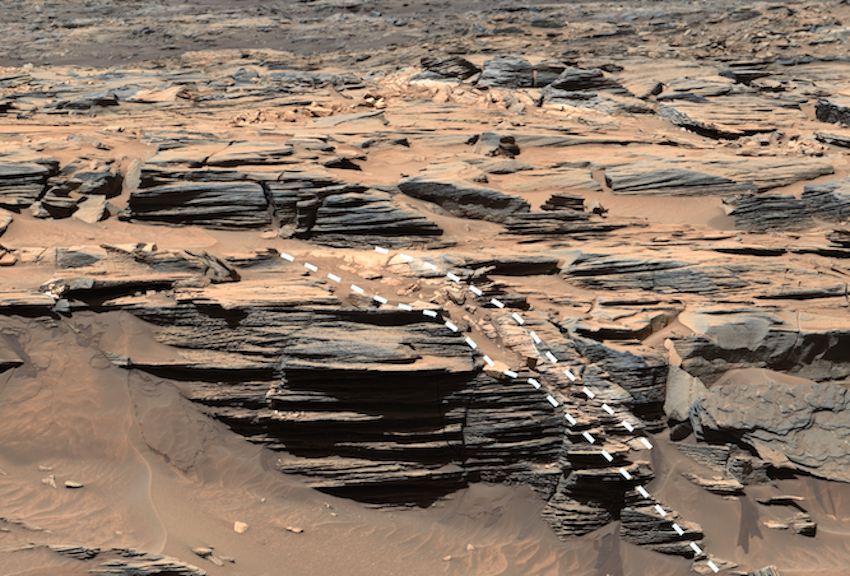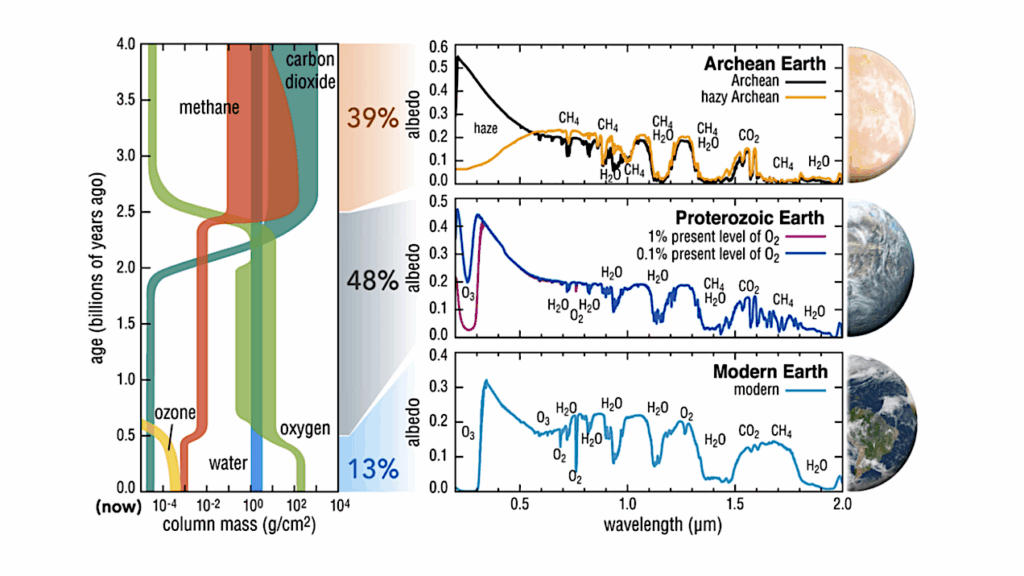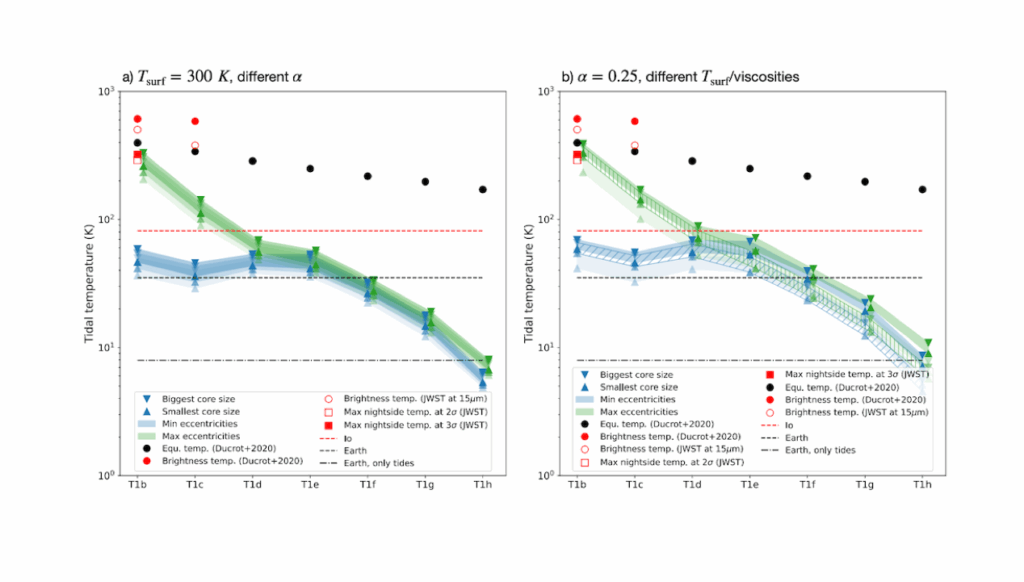Mars Curiosity Rover Discovers Water-rich Fracture Halo’s in Gale Crater

A research team using new methods to analyze data from NASA’s Curiosity rover and its neutron spectrometer Dynamic Albedo of Neutrons, or DAN, on Mars was able to independently verify that fracture halos contained water-rich opal, potentially serving as an important resource for human exploration.
The study finds that the vast subsurface fracture networks would have provided water-rich and radiation-shielded conditions that were potentially more habitable than those on the surface.
In 2012, NASA sent the Curiosity rover to Mars to explore Gale Crater, a large impact basin with a massive, layered mountain in the middle. As Curiosity has traversed along the Mars surface, researchers have discovered light-toned rocks surrounding fractures that criss-cross certain parts of the martian landscape, sometimes extending out far into the horizon of rover imagery. Recent work finds that these widespread halo networks served as one of the last, if not the last, water-rich environments in a modern era of Gale Crater. This water-rich environment in the subsurface would have also provided more habitable conditions when conditions on the surface were likely much more harsh.
As part of a new study published in the Journal of Geophysical Research: Planets, led by former Arizona State University NewSpace Postdoctoral Fellow Travis Gabriel, now a research physicist for the U.S. government, archival data from several instruments were examined and showed considerable anomalies near light-toned rocks earlier in the traverse. By happenstance, Curiosity rover drove right over one of these fracture halos many years ago, long before Gabriel and ASU graduate student and co-author Sean Czarnecki joined the rover team.
Looking at the old images, they saw a huge expanse of fracture halos extending far into the distance. By applying new methods for analyzing instrument data, the research team found something curious. These halos not only looked like halos found much later in the mission, in completely different rock units, but were similar in their composition: a whole lot of silica and water.
“Our new analysis of archival data showed striking similarity between all of the fracture halos we’ve observed much later in the mission,” Gabriel said. “Seeing that these fracture networks were so widespread and likely chock-full of opal was incredible.”
Gabriel and his team of researchers studied the composition of light-colored rocks surrounding the fractures on the ground, or fracture halos, in Gale Crater. Previous studies Gabriel was involved in used the rover’s laser-induced breakdown spectrometer, Chemistry and Camera, or ChemCam, to show that these halos may be composed of opal, a material that has important implications for the history of Gale Crater. Opal itself contains a large amount of water, which produced a strong signal in another instrument on the rover: the DAN spectrometer.
Observing drill cores taken at the Buckskin and Greenhorn drill sites many years into the mission, scientists confirmed that these light-toned rocks were very unique compared to anything the team had seen before.
“These light-toned rocks were lighting up in our neutron detector, producing anomalously high thermal neutron count rates,” Gabriel said.
In addition to looking back through archival data, Gabriel and his team went searching for opportunities to study these light-toned rocks again. Once they arrived at the Lubango drill site, a bright-toned fracture halo, Gabriel led a dedicated measurement campaign using the neutron spectrometer, confirming the opal-rich composition of fracture halos.
The discovery of opal is noteworthy as it can form in scenarios where silica is in solution with water, a similar process to dissolving sugar or salt in water. If there is too much salt, or conditions change, it begins to settle at the bottom. On Earth, silica falls out of solution in places like lake and ocean bottoms and can form in hot springs and geysers, somewhat similar to the environments at Yellowstone National Park.
Water-rich environments in the subsurface of Mars could have provided a safe haven from the harsh conditions on Mars’ surface, which is rather inhospitable compared to Earth. In Gale Crater, temperatures can go below minus 100 degrees Fahrenheit in the winter night time, reaching only up to roughly 30 degrees Fahrenheit in the warmest of afternoons. Gale crater also experiences far more radiation than the surface of Earth due to our much thicker atmosphere. Every day spent in Gale crater would expose you to a cosmic-source radiation dose that roughly equates to a daily pelvis X-ray.
Since scientists expect that this opal in Gale Crater was formed in a modern Mars era, these subsurface networks of fractures could have been far more habitable than the harsh modern-day conditions at the surface.
“Given the widespread fracture networks discovered in Gale Crater, it’s reasonable to expect that these potentially habitable subsurface conditions extended to many other regions of Gale Crater as well, and perhaps in other regions of Mars,” Gabriel said. “These environments would have formed long after the ancient lakes in Gale Crater dried up.”
The significance of finding opal on Mars will have advantages for future astronauts, and exploration efforts could take advantage of these widespread water resources. Opal itself is made up of predominantly two components: silica and water, with minor amounts of impurities such as iron. Since opal is not a mineral, the water is not bound as tightly within a crystal structure. This means that if you grind it down and apply heat, the opal releases its water. In a previous study, Gabriel and other Curiosity rover scientists demonstrated this exact process.
Although Gabriel and his team aren’t able to perform an exhaustive assessment of the water content in all halos, the dedicated neutron experiments they performed over two of these halos demonstrate that a single-meter halo could house roughly one to 1.5 gallons of water in the top foot of the surface.
New Martian water resource: Opal?
What does this research finding mean for future Mars exploration? The poles of Mars house a large amount of water ice among other volatiles like carbon dioxide. In the present day, the equator of Mars by comparison is water poor, showing no sign of widespread water ice resources in the near surface. The study suggests that water-rich opal may be lining many landscapes across regions of Mars where scientists otherwise don’t expect water.
Surprisingly, the opal in Gale Crater retains water despite the dry conditions of the modern-day atmosphere. Combined with growing evidence from satellite data that shows the presence of opal elsewhere on Mars, these resilient materials may be a great resource for future exploration activities elsewhere on Mars — that is, if opal elsewhere on Mars also retains water to the same degree as the opal in Gale Crater.
Opal forms in water-rich environments; however, it was found in fractures that formed much later in geologic time compared to the majority of rocks in Gale Crater. Much of Gale Crater’s rocks were formed in an ancient lake environment. This demonstrates that the water that formed the halos was around in the subsurface much later and that it was much more widespread than researchers thought.
Once opal forms, it tends to mature into a more crystalline form when exposed to water and fluctuating conditions. The fact that this opal was so well preserved suggests that once it was formed, there wasn’t much interaction with water thereafter. In these ways, discoveries from the Curiosity rover help us understand the where, when and what about water on Mars.
“It’s amazing to see Curiosity’s neutron detector, the rover’s only subsurface probe, which was originally only expected to survive for a few years into the mission, still providing fantastic results like these that reveal the nature of water and hydrated materials buried just below the Martian surface,” said Craig Hardgrove, co-author of the work, associate professor at ASU’s School of Earth and Space Exploration and scientist on Mars Science Laboratory Curiosity rover’s DAN team.
What’s next?
Gabriel and the team continue to investigate the role of water in the formation and alteration of martian rocks as the Curiosity rover heads up the central mound of Gale Crater, but no such luck has been made in discovering new halos at recent elevations. As a member of NASA’s latest rover team, Mars 2020 Perseverance rover, Gabriel is eager to explore silica-rich features in a new location on Mars to understand the nature of water-rich environments elsewhere on the red planet.
Astrobiology








